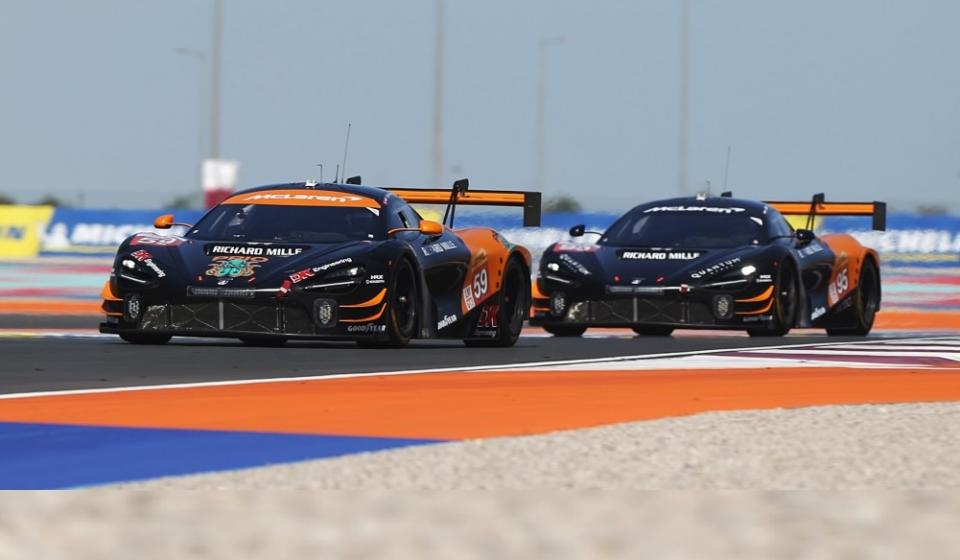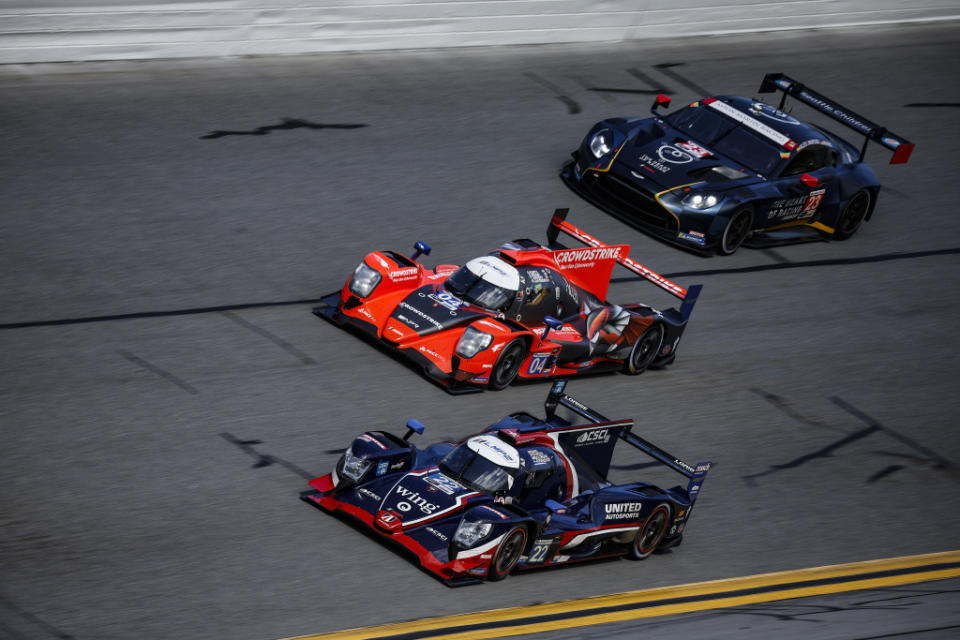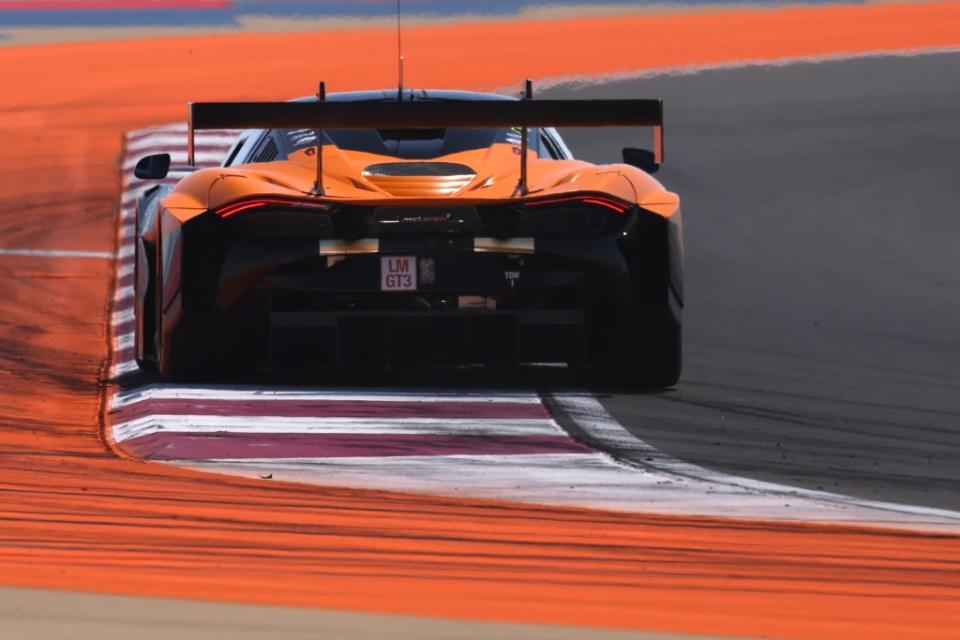McLaren flying under the radar in Le Mans return with United Autosports

Next year McLaren will commemorate 30 years since its one and only Le Mans victory, earned with the F1 GTR back in 1995. And with any luck it will have a presence in the 2025 edition of the 24 Hours as part of the LMGT3 class with the GT3 EVO and a shot at another victory on the Circuit de la Sarthe.
But that’s a storyline to revisit in 12 months, because right now celebrations surrounding the Woking, UK-based manufacturer’s heritage at the Grand Prix d’Endurance are already underway. Next week with United Autosports it will make its long-awaited return to the great race for the first time since the F1 GTR program’s final ride with Gulf Team Davidoff in 1998, and everyone involved is pushing hard to ensure it’s a memorable occasion.
Right now, few would point straight to UA as one of the favorites for an LMGT3 class win. However, this is an effort that deserves real attention and shouldn’t be counted out for a strong finish.
Yes, next year is arguably the more important one for the brand and its increasing efforts to recognize past achievements. But United Autosports’ staff has been working overtime to ensure the team is ready for the task at hand in year one of what it hopes will be a long and successful program.
The start to life in LMGT3 has been far from easy for Richard Dean and Zak Brown’s Yorkshire-based team. The program came together “three months late” in October, leaving it with a mountain to climb over the winter.
Signing drivers and organizing a test program was complicated, getting its head around the GT3 EVO was never going to be the work of a moment and the new LMGT3 ruleset — while widely accepted as a step forward for the Balance of Performance-governed formula — has only added to the task list with the addition of torque sensors, mandated power curves and virtual energy tanks.
On top of that, it also shouldn’t be ignored that United Autosports’ is far from just an FIA World Endurance Championship team. Alongside its new-look WEC campaign, it continues to run its title-winning ELMS LMP2 program, a new multi-car LMP2 effort in IMSA’s WeatherTech Championship and a wide-ranging historic restoration and race arm.
United Autosports continues its long run of LMP2 success in IMSA as well as Le Mans, but had to start fresh in LMGT3 to maintain its foothold in the FIA WEC. Michael Levitt/Motorsport Images
Scaling up for 2024 has been a colossal task but over more than a decade the Anglo-American team has been building itself into a powerhouse in prototype racing at a steady pace, enabling it to accommodate high-level efforts in three major championships at the same time without stretching itself too thin.
This is in part because it now boasts high-level facilities on both sides of the Atlantic, giving the team the capacity to make this big step. Its Wakefield facility serves as a base for its WEC, ELMS and historic programs, while the new shop in Mooresville, N.C. houses its IMSA team via a partnership with Jr III Racing. The impact this has had on both its capabilities and image cannot be understated.
Behind the scenes, the selection process at McLaren headquarters for a WEC partner team last year proved both lengthy and tricky to navigate. Four highly credible teams were understood by RACER to have been in the mix, all boasting previous success in the sport. Yet after much deliberation, United was chosen.
On the face of it, due to Zak Brown’s roles as a co-owner of United and CEO of McLaren Racing, it may look like the obvious choice. But there was so much more to it than that. UA offered something that none of the other teams in the room could: a laundry list of major race and title wins in European and global competition and a longstanding association with ACO racing.
The latter part was crucial, because getting space on the LMGT3 grid was never a guarantee for McLaren, as it was unable to gain priority via a Hypercar program. It therefore needed to put together the case that United Autosports — which had come close to securing a factory Hypercar deal more than once over the past two years — deserved to remain in the WEC for a fifth season in the wake of the LMP2 class being removed. It was an edgy few weeks as everyone waited for the final entry list to be published, but in the end, McLaren’s pitch paid off. Since then, it’s been all-systems-go.
In a technical sense, since receiving its first chassis last October, getting to grips with the nuances of LMGT3 has taken the most time. Jakob Andreasen, United’s technical director — whose background prior to joining the team includes stints in Formula 1 with Force India, McLaren and Williams and in the FIA WEC with Toyota Gazoo Racing — says the team has relished the challenge.
“It’s been intense as we have new technology to contend with,” he tells RACER. “The power and energy management from the torque sensors is new and as a concept is fantastic. But as with any new technology, there’s uncertainty and added complexity that we’ve had to work with McLaren on. And it’s been even tougher for us because many of the manufacturers in the class are already in Hypercar and therefore had previous insight into torque sensors going in, because they’re part of that ruleset too.
“Thankfully, we are happy and the drivers have been happy with the car’s base setup and handling characteristics. That’s enabled us to exploit the car’s performance well. It has also allowed us to focus on software development in the background. This is an area of GT3 racing that is rarely talked about. It has open software so there is potential for developing systems on the car.
“With torque sensors, virtual energy and mandated power curves, there’s nothing really you can do to make the car faster in terms of downforce, power and energy yourself. But there is potential for driver aids in order to make their life easier with more information being shown on the driver display. For instance, this helps drivers manage tires and car temperatures over a stint so we are always in the right performance window.”
As the team has become more familiar with the finer details of operating a WEC GT program, strides forward have been taken consistently. The Prologue test and opening race at Qatar were a baptism of fire, though, the two GT3 EVOs coming home 13th and 14th on their race debut.
“We were all a bit overwhelmed,” team co-owner Richard Dean admits. “In Qatar, there was so much happening in a short period and having the first race in the Middle East, with all the shipping requirements was so difficult.
“A big part of it was kit. When you’re in a category for years and years you build up kit and spares, so you can go testing while shipping cars to races. This time we were sending cars off while we were still trying to gear up.”
Along with learning about its McLaren 720S LMGT3 Evo, UA has been exploring the nuances of the LMGT3 ruleset. JEP/Motorsport Images
Since then, progress has been steady. Imola saw the No. 95 of Josh Caygill, Nico Pino and Marino Sato score the team its first points, then at Spa — the red-flagged and extended Le Mans dress rehearsal — the No. 59 of James Cottingham, Nicolas Costa and Gregoire Saucy finished just shy of the podium in fourth.
“It was two significant steps in a row,” Dean says, “and if you’d have said to us in Qatar that by the time we were at the third race, we’d be capable of qualifying on the front row and leading the race, I’m not sure I’d have believed it. It’s a credit to the team.”
The team’s WEC sporting manager Charlie Kemp also feels the hard work is paying off.
“There have been curveballs thrown at us at all three races so far, but we’ve taken them in our stride because we are always looking at areas where there is for room for improvement,” he tells RACER. “The jump we made through the issues we had at Qatar, to fighting for a podium at Spa, has been massive. The car can do the job. We know that. We’ve just had to strengthen our knowledge to get the most out of it.
“There is just so much new with the ruleset that’s alien to McLaren and the team. But we have moved through this very quickly and we feel focused on getting a result at Le Mans rather than surviving it.
“The task has been big for us because you’d be surprised how different a GT3 and an LMGT3 car are. And for McLaren too — we’ve had to work closely with them. They’ve been very consistent in their level of support.”
LMGT3 as a whole has been gradually heating up. Spa produced the best race for the new formula so far, with door-to-door action all the way to the last lap when the two Manthey Porsches exchanged positions for the win. So while most of the attention will be paid to the 23-car Hypercar class at Le Mans, there’s a good chance that LMGT3 gets more than its fair share of air time.
There’s very little GT3 data on the circuit for the teams to refer to going in. There should also be an opportunity to truly stretch the envelope on tire life with Goodyear’s F1 Eagle Super Sports for the first time, experimenting with triple and quad stints overnight. It will all be fascinating to track.
“At Le Mans, you can extend stints and buy yourself strategic time, but you have to be careful,” Andreasen explains. “You need to maintain temperatures because you cannot change compounds like you can in Hypercar. You can’t go soft at night and high during the day, so everyone will need to be careful not to drop out of the window, despite the fact that deg is low.
“We’ll need to be clever during the track time throughout the week so we make the right calls.”
McLaren connections are on full display at UA’s Wakefield, UK shop.
Strolling through United Autosports’ Wakefield base with the GT3 EVOs in their final stages of preparation underscored that nothing about United’s WEC commitment with McLaren screams “one-year wonder.” This is a team that does nothing by half measures and takes great pride in its work.
“To represent McLaren in motorsport is a privilege. It’s a name that has many victories in different categories,” Dean says when asked how it feels to be handed the responsibility of representing a brand with so much heritage in such an important event. “The focus for us, of course, is to replicate the famous victory at Le Mans. That lands on our shoulders, and there’s a lot of expectation around the brand going back after such a successful period in the mid-’90s.
“We are not here to make any definitive claims that we are going to win right now, but we are going to give it a good go. There’s natural pressure because McLaren is doing so well in motorsport, winning in F1, and finishing on the podium in IndyCar and Formula E recently. So all eyes are on us. But thankfully we are working with a partner that is realistic.”
Over the years United has proven time and time again in LMP competition that it is capable of beating anyone. It has LMP2 titles in the WEC, European and Asian Le Mans Series and a Le Mans class win on its résumé. Now, with the support of McLaren for a fight against teams representing seven other blue-chip manufacturers, we will find out if it can deliver the goods yet again in GT3 racing at the highest level.
“With this effort, we’re taking on the motorsport departments at BMW, Ferrari, Porsche and General Motors,” Dean concludes. “It’s a big deal. And we know that if we are successful we can grow everything. We can grow our team and McLaren’s motorsport side in sports car racing. It’s an exciting time.”

 Yahoo Autos
Yahoo Autos 


